Silk in China
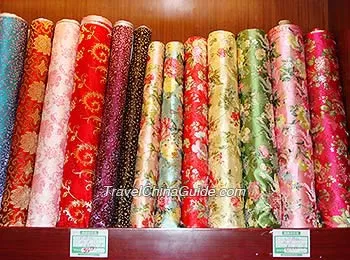 "A silkworm spins all its silk till its death and a candle won't stop its tears until it is fully burnt." This Tang poem accurately describes the property of the silkworm. Despite technological development, a silkworm can only produce a certain amount of silk---1000 meters (3280feet) in its lifespan of 28 days. The rarity of the raw material is the deciding factor of both the value and the mystery of silk.
"A silkworm spins all its silk till its death and a candle won't stop its tears until it is fully burnt." This Tang poem accurately describes the property of the silkworm. Despite technological development, a silkworm can only produce a certain amount of silk---1000 meters (3280feet) in its lifespan of 28 days. The rarity of the raw material is the deciding factor of both the value and the mystery of silk. Legend has it that in ancient times, Lei Zu, the wife of Huang Di , taught people how to raise silkworms and how to extract the silk.
The Warring States Period, the beginning of feudalist society in Chinese history, witnessed a prosperous time. The development of productivity popularized silk and it was no longer a luxury just for aristocrats. The pattern, weaving, embroidery and dyeing skills were all improved as they were influenced by the free ideology of the time, while the silk designs had sense of a free and bold air about them.
The silk products excavated from Mawangdui Han Tomb are proof of the advanced skill and artistry of silk at this time.
Silk production peaked during the Han Dynasty when the manufactured goods were transported as far away as Rome from Chang'an (today's Xian). The overland trade route was to become famously known as the Silk Road. However, there was also a Marine Silk Road extending from Xuwen, Guangdong or Hepu, Guangxi to Vietnam. An outward bound voyage lasting five months would arrive in Vietnam; it would take another four months to reach Thailand; while a further twenty days would carry the merchants on to Burma. Two months later they would arrive in India and Sri Lanka, from where the silk would be eventually transported to Rome via the Mediterranean. After such a long journey, the price of silk was equivalent to that of gold. Legendary as it seems, tender silk connected China to the rest of the world.
During subsequent dynasties, professional designers created novel patterns and improved the machines.
The Marine Silk Road took supremacy over the land Silk Road following the Song Dynasty extending the trade to Southeast Asia which became fully developed in the Yuan Dynasty. Besides Chinese exports, foreign businessmen also came to China to buy silk and china wares.
During the Ming and Qing Dynasties silk was transported to Europe and America from Manila and this meant that China dominated the world's silk market until 1908.
Chinese characters including the component "silk" have the intonation of silk or its implication of fine and deep. The richness of color, texture, strength and beauty of silk make it the means to imply something is fine and impeccable. A woman's raven hair is referred to as 'black silk' ; tender feelings are 'feelings of silk' and the Chinese word for a lingering and emotive feeling contains the component of "silk", and even a flavor can be silky and smooth.
![]() Major local silk products of China
Major local silk products of China
Shu Brocade
Shu Brocade made in Sichuan originated from Han and reached its heyday in the Wei, Jin, Sui and Tang Dynasties. With red as the predominate color, Shu Brocade has a variety of designs, fully reflecting the flowery nature of Shu Culture. In the Tang Dynasty, Dou Shilun, Duke Lingyang, created a set of designs for Shu Brocade, which was known as the "Duke Ling Yang Pattern".
Yun Brocade
Yun Brocade was developed during the Yuan Dynasty although its origin could date back to the Southern Dynasty. Historical records suggest that prior to the Southern Dynasty there was no brocade in Nanjing until Emperor Liu Yu (363-422) had workers move to Jiankang (today's Nanjing) and established production there. Yun Brocade features quality material, refined weaving and the wide use of gold and silver threads. This magnificence gained the name of Yun, which is Chinese for 'cloud'. Elegant Yun Brocade ultimately became a precious artwork and no longer a fabric for day to day wear. In the Yuan, Ming and Qing Dynasties Yun Brocade was a royal tribute.
As the unique weaving skill cannot be undertaken by modern machinery, Yun Brocade remains very expensive.
Song Brocade
Song Brocade, as the name implies, originated from the end of Northern Song. Record has it that a Mr. Ji used Song Brocade for the paperhanging of some precious calligraphy copies. In all there were twenty different designs of this brocade. When the Ji family declined, they wanted to sell the copies but failed to do so due to the high price they demanded. Later some rich man bought them and used the brocade as patterns in workshops in Wu (today's Suzhou area). He made a substantial profit from it! This is regarded as the origin of Song Brocade. And it inherits the old tradition---today Song Jin is mainly used for paperhanging.
![]() Brocades by Ethnic Groups
Brocades by Ethnic Groups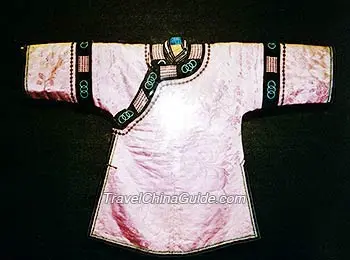
Zhuang Brocade
Zhuang Brocade is the creation of the Zhuang ethnic group in Guangxi. Zhuang Brocade features rich colors, as this is the artistry of Zhuang people. The patterns vary from waves, clouds, grass and flowers to animals. Phoenix, the symbol of auspiciousness, takes a dominant role in these designs. Zhuang Brocade is durable and can be widely used in beddings, belts, bags and clothes.
Dong Brocade
Dong Brocade from Hunan features softness and neatness.
Li Brocade
Li Brocade from Hainan is firm with bold primitive designs.
Tujia Brocade
Tujia Brocade from the west of Hunan and Hubei is known for its mass, variety of designs and gorgeous colors.
Yao Brocade
Yao Brocade from Hunan is notable, too. The Brocades for bedding are neat and light in color with simple designs while those for clothes are flowery. Some of the symbols woven into Yao Brocade are regarded as the legendary "female characters", which are limited among women. Women use these special symbols or characters to convey messages. Though there is no way of telling if the female character is a branch of an ancient oracle system or that of Yao words, Yao Brocade has become a medium of such a mystery.
Hang Brocade made in Hangzhou, Jing Brocade from Jiangling, Hubei, and Ning Silk from Nanjing, Jiang Silk form Zhenjiang, Jiangsu Province, Hu Crape from Huzhou, Zhejiang Province all occupy outstanding roles in the history of Chinese silk.
China Ethnic Craft: Chinese Folk Toys
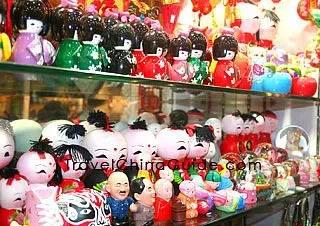 As an indispensable part of traditional folk art, toys are a unique expression of the long and uninterrupted Chinese history. Religious beliefs, world view, taste, classical works and local customs, especially festivals and the 'Four Great Classical Chinese Literatures', are all represented by the use of various techniques requiring an artisans' deepest wisdom and creativity. The advantage is that the greater majority of people can enjoy the pleasure of toys that are easier to make and more widely available than other artistic works such as jade or silver wares, as they tend to utilize common articles that are readily available, such as cloth, grass, straw, clay, paper, and so on. Even so, it should be noted that these toys are not of a coarse manufacture, but of rustic simplicity and vivacity.
As an indispensable part of traditional folk art, toys are a unique expression of the long and uninterrupted Chinese history. Religious beliefs, world view, taste, classical works and local customs, especially festivals and the 'Four Great Classical Chinese Literatures', are all represented by the use of various techniques requiring an artisans' deepest wisdom and creativity. The advantage is that the greater majority of people can enjoy the pleasure of toys that are easier to make and more widely available than other artistic works such as jade or silver wares, as they tend to utilize common articles that are readily available, such as cloth, grass, straw, clay, paper, and so on. Even so, it should be noted that these toys are not of a coarse manufacture, but of rustic simplicity and vivacity. Generally, the diverse variety of folk toys can act as decorations to be appreciated or as knickknacks to be played with. As such, the two categories are those for festival decoration and those for daily enjoyment.
Festival Toys
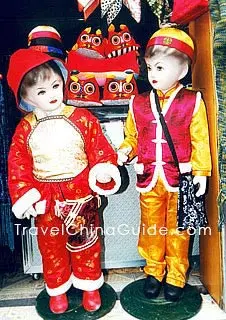 Toys during festivals are quite flowery and customary. In the Spring Festival, people use firecrackers and fireworks; in the Lantern Festival, there are lanterns in the shape of lotus, monkeys, dragons, etc; in the Pure Brightness kites will be flown in the blue sky; and during the Dragon Boat Festival, people will take sachet with them. Old people's sachet looks like a peach, symbolizing longevity while children's sachets are of lovely patterns, with fragrant herbs inside to ward off evil spirits. In ancient times, they were also a token of love that a girl would give to her beloved.
Toys during festivals are quite flowery and customary. In the Spring Festival, people use firecrackers and fireworks; in the Lantern Festival, there are lanterns in the shape of lotus, monkeys, dragons, etc; in the Pure Brightness kites will be flown in the blue sky; and during the Dragon Boat Festival, people will take sachet with them. Old people's sachet looks like a peach, symbolizing longevity while children's sachets are of lovely patterns, with fragrant herbs inside to ward off evil spirits. In ancient times, they were also a token of love that a girl would give to her beloved.
For Appreciation
Toys for appreciation and decoration stresses artistic conception. Carvings on root, stone and nut, painted eggshell, modeling with clay, porcelain and wax are all exquisite, especially those of figurines with their natural beauty.
Cloth paste pictures (collages) are interesting and distinctive. Most of its artisans are women who are good at needlecraft. Up until quite recently, almost every girl was able to make clothes and shoes out of cloth, with the off-cuts being used as convenient materials for collages. Choosing a large piece of cloth on which to sew or collage into the basic pattern, then adorn it with small pieces of lace. Utilizing color and texture and finished off with butterflies, tigers, children and real flowers are very appealing.
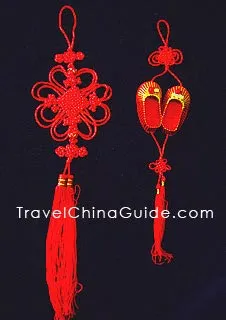 The Hairy Monkey was probably invented in Beijing during the Qing Dynasty (1644-1911). By sticking many shaggy magnolia flower buds color resembles a monkey's fur, the lively posture of a monkey can be presented. As these materials are not readily available, this folk art is a lot rarer.
The Hairy Monkey was probably invented in Beijing during the Qing Dynasty (1644-1911). By sticking many shaggy magnolia flower buds color resembles a monkey's fur, the lively posture of a monkey can be presented. As these materials are not readily available, this folk art is a lot rarer.
During the very early period of Chinese cultural development, the ancestors had worshiped the immortals. Rope, pronounced as 'Sheng', shared a similar pronunciation with the word for gods ('Shen' in Chinese), and when written, it looked like a dragon, an auspicious animal in Chinese culture; knots, in Chinese 'jie' means vigor, harmony, and unification, Therefore, this unique Chinese knots artwork has been a popular gift for thousands of years and embodies best wishes. People wore it in the beginning as a decorative addition to clothing, and later, used it to decorate their houses. Though the weaving techniques are complicated, ropes, in hands of a deft craftsman appear effortless moving the shuttle in between the rows of ropes. A Chinese knot is usually symmetrical in structure and colorful with jade or porcelain beads. This no doubt adds more jubilation to any festive atmosphere.
Euphonious Toys
Sounds can increase the amusement of toys. The main euphonious toys are whistles made of clay, porcelain, and bamboo. The simplest way is to blow directly along the edge of a leaf or blade of grass. Shadow puppets, displayed on the screen and steered by people behind, and the rattle-drum which can make the rattling sound by shaken are also favorites amongst children.
Play with Wisdom
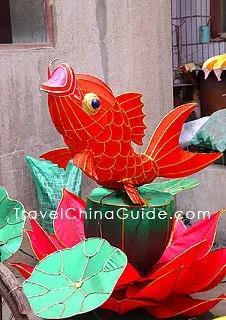 For Chinese who attach a great importance to the development of children's wisdom, jigsaw puzzle ('Qiqiaoban') might be the most ideal choice. Composed of 7 pieces in a certain shape, this toy requires one's brain exertion to join those pieces into a given pattern without leaving any gaps. The puzzle ring is another well-known game. It is said to originate from the Warring States Period (476–221 BC). Appearing to be one of the most incomprehensible games in the human history, it even aroused the attention of Western mathematicians. To separate the nine rings which are buckled together or to join separated nine rings together is quite intricate indeed.
For Chinese who attach a great importance to the development of children's wisdom, jigsaw puzzle ('Qiqiaoban') might be the most ideal choice. Composed of 7 pieces in a certain shape, this toy requires one's brain exertion to join those pieces into a given pattern without leaving any gaps. The puzzle ring is another well-known game. It is said to originate from the Warring States Period (476–221 BC). Appearing to be one of the most incomprehensible games in the human history, it even aroused the attention of Western mathematicians. To separate the nine rings which are buckled together or to join separated nine rings together is quite intricate indeed.
Practical Toys
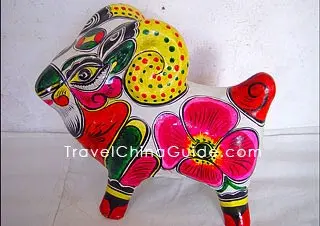 Besides being for play, folk toys can also be of practical use, as part of finery, bedding and foodstuff. Children love animal-shaped pillows or hats. Today, the mascot of Olympic Games 2008 in Beijing is the lovely panda hat to numerous zealots. For the foodstuff, flour's plasticity helps people's imagination come true. In Shanxi Province, people are still experts at steaming flour figures. Suppose how pleasant they will be when seeing vivid edible flour rabbits and pigs!
Besides being for play, folk toys can also be of practical use, as part of finery, bedding and foodstuff. Children love animal-shaped pillows or hats. Today, the mascot of Olympic Games 2008 in Beijing is the lovely panda hat to numerous zealots. For the foodstuff, flour's plasticity helps people's imagination come true. In Shanxi Province, people are still experts at steaming flour figures. Suppose how pleasant they will be when seeing vivid edible flour rabbits and pigs!
Art and Craft in China: Jade
Jade has influenced all walks of life. In ancient times, people expressed abstract notions with concrete patterns of Chinese character, which were influenced by Taoism and Buddhism. Jade craftworks were among the most precious and luxurious ones; people wore and decorated rooms to indicate loyalty, elegance, beauty, and eternity. The most popular patterns were: peach (longevity), mandarin duck (love), deer (high official ranks), bat (blessing), fish (affluence), double phoenixes (thriving), bottle (safety), lotus (holiness), bamboo (lofty conduct), and fan (benevolence), etc.
In Chinese, jade is pronounced as 'Yu', and most words related to moral include this word such as 'Unpolished jade never shines,' indicating that one cannot be a useful person if he is not educated. Jade also implied honor and conviction. Many girls in ancient times were also named with jade to reflect the love of their parents. One of the Four Beauties in Chinese history, Yang Yuhuan, the beloved concubine of Emperor Xuanzong in the Tang Dynasty (618 - 907), was their representative. Yang is her surname and her given name Yuhuan means simply 'jade ring'.
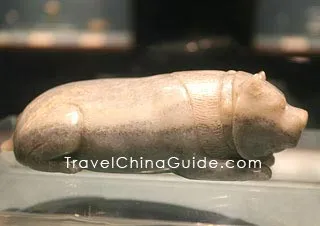 People believed that jade was the expression of the most beautiful stone. A beautiful piece can be more valuable than fifteen cities and a man's life. Historic records tell of a story about a stanch man named Bian He who had a piece of jade called 'Heshi Bi' which was said to be the most priceless treasure in history. However, when Bian He discovered the piece, it was hidden under the veil of the coarse stone in which it laid. He did not dare to carve it but instead dedicated it to the King of State Chu. He never knew that he would pay two legs for his dedication, for the king did not know the real value of the jade and cut Bian He's legs off. He cried for three days and nights. Afterwards, the new king heard of him and wanted to see whether his jade was as precious as he said. When the jade was cut, all were startled by the delicate quality. Very soon, it became a national treasure and was called 'Heshi Bi'. So precious was the stone that it even became a source of conflict between the Qin State and Zhao State.
People believed that jade was the expression of the most beautiful stone. A beautiful piece can be more valuable than fifteen cities and a man's life. Historic records tell of a story about a stanch man named Bian He who had a piece of jade called 'Heshi Bi' which was said to be the most priceless treasure in history. However, when Bian He discovered the piece, it was hidden under the veil of the coarse stone in which it laid. He did not dare to carve it but instead dedicated it to the King of State Chu. He never knew that he would pay two legs for his dedication, for the king did not know the real value of the jade and cut Bian He's legs off. He cried for three days and nights. Afterwards, the new king heard of him and wanted to see whether his jade was as precious as he said. When the jade was cut, all were startled by the delicate quality. Very soon, it became a national treasure and was called 'Heshi Bi'. So precious was the stone that it even became a source of conflict between the Qin State and Zhao State.
![]() Jadeite
Jadeite
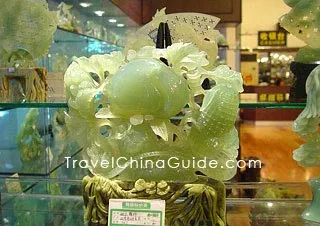 As early as the 16th century, Jadeite was believed to be a precious and hard jade with healing qualities for the human stomach and kidneys. Since it was brought into China during the early Qing Dynasty (1644 - 1911), it had been doted on greatly. Jadeite contains an iron component which appears red, chromium that appears green, and many other colored types. Known as the 'king of jade', it is usually a more expensive type of jade.
As early as the 16th century, Jadeite was believed to be a precious and hard jade with healing qualities for the human stomach and kidneys. Since it was brought into China during the early Qing Dynasty (1644 - 1911), it had been doted on greatly. Jadeite contains an iron component which appears red, chromium that appears green, and many other colored types. Known as the 'king of jade', it is usually a more expensive type of jade.
![]() Nephrite Jade
Nephrite Jade
Nephrite's robustness is due to the fact it contains tremolite. It also can be divided into several sub-classifications according to color: white, grey, green, topaz, and black jade.
In China, the most reputable jade producing area is Hetian in Xinjiang Province. Hetian jade is so hard that it can scratch glass. It has often been found in very huge pieces. An example of this is the huge jade hill on which the grand scene of Yu the Great leading people to control flood is elaborately carved. It was 5,350 kg weight (11,795 pounds) when it was completed. Now this artwork is displayed in the Forbidden City.
Serpentine jade, or Xiu yu in Chinese, is mainly from Xiuyan County in Liaoning Province. Made of many different ingredients, it takes on various appearances: white, yellow, light yellow, pink, green, dark green, light green and so on. This type of jade is usually coloured in various shades of green. Usually serpentine jade is semi-transparent or even opaque like wax.
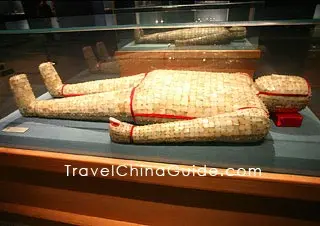 Lantian jade is produced in Lantian County, north of Xian in Shaanxi Province. It was also among the most charming ancient jades, for its rigidity made it easier to be carved into decorations and jewelry by our ancestors. The hue is uneven in colors of yellow or light green.
Lantian jade is produced in Lantian County, north of Xian in Shaanxi Province. It was also among the most charming ancient jades, for its rigidity made it easier to be carved into decorations and jewelry by our ancestors. The hue is uneven in colors of yellow or light green.
Nanyang County in Henan Province is famous for its abundant Nanyang jade. The ore district is located on an isolated 200 meter high hill, called Dushan Hill (thus its other name of 'Dushan jade'). It is distinctive for its whimsicality. Among the Nanyang jade artworks, you will find rare purple, blue and red ones.
![]() Appreciation and Maintenance
Appreciation and Maintenance
Experts believe that, although more expensive, diamonds and gold cannot be compared with jade - jade is animated with a soul. They often buy to collect their favorite jade artworks, while people with little knowledge of jade may buy coarse works.
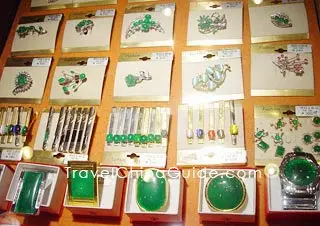 To obtain a real and choice jade article, you should take pains to learn and appreciate it. The criteria lie in the brightness of color and luster, compactness of inner structure, and the delicacy of the craftwork. For example, nephrite creates an oily luster and jadeite creates a vitreous luster. Tiny cracks can lower the value of jade; on real jade, air bubbles cannot be seen; the more lenitive the higher quality of jade, and so on.
To obtain a real and choice jade article, you should take pains to learn and appreciate it. The criteria lie in the brightness of color and luster, compactness of inner structure, and the delicacy of the craftwork. For example, nephrite creates an oily luster and jadeite creates a vitreous luster. Tiny cracks can lower the value of jade; on real jade, air bubbles cannot be seen; the more lenitive the higher quality of jade, and so on.
Having purchased a jade article is just half the process of collecting. Jade is like a child that needs constant care. Enthusiasts need to work more to maintain this artwork, or blemishes may appear.
![]() First, avoid bumping on hard surfaces as jade is delicate. Although sometimes a crack cannot be seen by the naked eye, the interior structure may have been damaged. As time goes on, it will appear and reduce the value of the piece.
First, avoid bumping on hard surfaces as jade is delicate. Although sometimes a crack cannot be seen by the naked eye, the interior structure may have been damaged. As time goes on, it will appear and reduce the value of the piece.
![]() Second, protect jade articles from dust or greasy dirt. If tainted, they must be scrubbed with a soft brush and light suds and washed with clean water.
Second, protect jade articles from dust or greasy dirt. If tainted, they must be scrubbed with a soft brush and light suds and washed with clean water.
![]() Third, when left unused it is best to store the jade in a case or box to protect it from being bumped.
Third, when left unused it is best to store the jade in a case or box to protect it from being bumped.
![]() Fourth, jade should be kept away from perfume, perspiration or chemicals. The brightness of jade risks corrosion, especially emerald and other high quality jade, so it is better to clean it with a soft cloth after wearing it.
Fourth, jade should be kept away from perfume, perspiration or chemicals. The brightness of jade risks corrosion, especially emerald and other high quality jade, so it is better to clean it with a soft cloth after wearing it.
![]() Fifth, do not expose jade to sunlight for a long time, or it may expand and the quality will change slightly.
Fifth, do not expose jade to sunlight for a long time, or it may expand and the quality will change slightly.
Finally, jade has certain water content so keep it in an area of humidity to protect it from over-drying.
Chinese Bronze Vessels
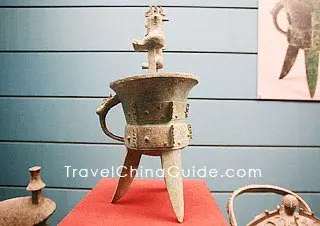 Bronze is the alloy of copper, stannum and plumbum. After the invention of this alloy 5,000 years ago, bronze prevailed immediately and led our ancestors into a newstage - the bronze era.Generally speaking, bronze culture underwent three stages, that is, the forming period, the thriving period, and the turning period. The forming period indicates the Longshan Culture 4,500 - 4,000 years ago in the Neolithic Age; while the thriving period from Xia, Shang to the Zhou Dynasties (11th century BC - 221 BC), the artistic achievements of bronze vessels were extremely brilliant: bronze was widely used mostly as musical instruments in sacrificial temples, as weapons of war and other vessels in court life.
Bronze is the alloy of copper, stannum and plumbum. After the invention of this alloy 5,000 years ago, bronze prevailed immediately and led our ancestors into a newstage - the bronze era.Generally speaking, bronze culture underwent three stages, that is, the forming period, the thriving period, and the turning period. The forming period indicates the Longshan Culture 4,500 - 4,000 years ago in the Neolithic Age; while the thriving period from Xia, Shang to the Zhou Dynasties (11th century BC - 221 BC), the artistic achievements of bronze vessels were extremely brilliant: bronze was widely used mostly as musical instruments in sacrificial temples, as weapons of war and other vessels in court life.Decorative patterns then were the most delicate and diverse. Popular patterns were the lines of beasts' faces which seemed mysterious and the lines depicting dragons and phoenix which were believed to be mighty and auspicious. Gradually people developed more complicated means of adorning their vessels. They inset jade, turquoise, iron or copper into the bronze vessels for which posterity admired their wisdom with awe. Ding, is a kind of vessel that could cook and be only possessed by kings and officials, excluding common people. 133 centimeters (52.4 inches) high and 875 kilometers (1,929 pounds) heavy, Simuwu Fang Ding, the largest and heaviest bronze vessel in China, was believed to be forged by a king of the Shang Dynasty (16th - 11th century BC) for worshiping his mother. It represented the highest artistic level of bronze.
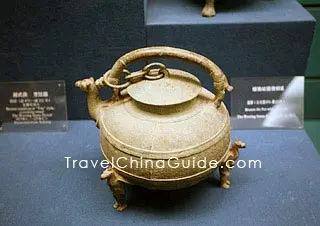 In the Spring and Autumn Period and the Warring States Period, military affairs depended highly on weapons so that each state tried to make practical bronze ones. The king of the Yue State, Gou Jian, had made the famous Goujian Sword which was still sharp and without any rust when excavated. Another legendary artisan Gan Jiang was even said to be able to cast a bronze sword possessing a wizard's power!
In the Spring and Autumn Period and the Warring States Period, military affairs depended highly on weapons so that each state tried to make practical bronze ones. The king of the Yue State, Gou Jian, had made the famous Goujian Sword which was still sharp and without any rust when excavated. Another legendary artisan Gan Jiang was even said to be able to cast a bronze sword possessing a wizard's power!
Till the Han Dynasty (206BC - 220), the place of bronze vessels was substituted for those of jade, pottery, and iron. Afterwards, bronze was mostly used for mirrors in various shapes and patterns, although the inscriptions on them are of a very high value. From: www.travelchinaguide.com.
Chinese Painting
The tools used in traditional Chinese painting are paintbrush, ink, traditional paint and special paper or silk.
Chinese painting developed and was classified by theme into three genres: figures, landscapes, and birds-and-flowers.
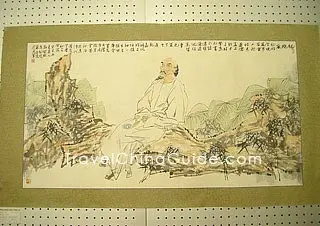 The birds-and-flowers genre has its roots in the decorative patterns engraved on pottery and bronze ware by early artists. Among the common subjects in this genre, which reached its peak during the Song Dynasty (960 - 1279), are flowers, bamboo, birds, insects, and stones. The genre flourished under Emperor Huizong (1082 - 1135), who was an artist himself and excelled at both calligraphy and traditional painting, especially paintings of exquisite flowers and birds.
The birds-and-flowers genre has its roots in the decorative patterns engraved on pottery and bronze ware by early artists. Among the common subjects in this genre, which reached its peak during the Song Dynasty (960 - 1279), are flowers, bamboo, birds, insects, and stones. The genre flourished under Emperor Huizong (1082 - 1135), who was an artist himself and excelled at both calligraphy and traditional painting, especially paintings of exquisite flowers and birds.
Painters who specialized in figures included images of immortals, emperors, court ladies, and common people in their works. Through their depictions of such scenes and activities as feasts, worship and street scenes, these artists reflected the appearance, expressions, ideals, and religious beliefs of the people. Chinese figure painting prominently features verve. The portrayal of figures saw its heyday during the Tang Dynasty (618 - 907). The master of painting, Wu Daozi (about 685 - 758), created many Buddhist murals and other landscape paintings that are marked by variety and vigor. One of his best known works is a depiction of the Heaven King holding his newborn son Sakyamuni to receive the worship of the immortals.
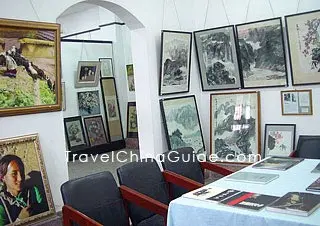 As far back as the Northern and Southern Dynasties (386 - 589), landscape painting separated from the figure genre and continued to enjoy popularity through the Tang Dynasty. This style reflected people's fondness for nature. The artist's use of ink and brush to paint a landscape changed, depending on the scenery itself, the weather (sunny or rainy day), the time of day (morning or night), and the season. The earliest known landscape painting was the Spring Outing by Zhan Ziqian of the Sui Dynasty (581 - 618). It shows an enchanting spring scene with people enjoying popular activities: gentlemen riding and ladies boating. A waterfall behind a bridge, near slopes and distant mountains are drawn with clear, fluent lines.
As far back as the Northern and Southern Dynasties (386 - 589), landscape painting separated from the figure genre and continued to enjoy popularity through the Tang Dynasty. This style reflected people's fondness for nature. The artist's use of ink and brush to paint a landscape changed, depending on the scenery itself, the weather (sunny or rainy day), the time of day (morning or night), and the season. The earliest known landscape painting was the Spring Outing by Zhan Ziqian of the Sui Dynasty (581 - 618). It shows an enchanting spring scene with people enjoying popular activities: gentlemen riding and ladies boating. A waterfall behind a bridge, near slopes and distant mountains are drawn with clear, fluent lines.
During the Ming (1368 - 1644) and Qing (1644 - 1911) Dynasties, innovation was stressed, and delicate seal marks, calligraphy, poems and frames increased the elegance and beauty of the paintings.
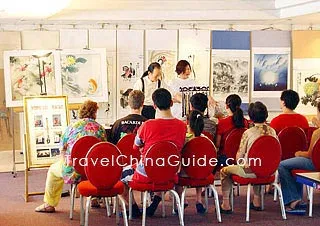 Much skill is required of the Chinese painter, who must wield the soft brush with strength and dexterity to create a wide variety of lines--thick, thin, dense, light, long, short, dry, wet, etc. Depending on his skills, he might specialize in detailed and delicate line drawing (Gongbi) or abstract, impressionistic (Xieyi) paintings. Line drawing is the basic training of a painter, who must learn it well before moving on to the delicate details of realistic scenes or the more abstract spirit of impressionism. Another special skill worthy of mention is painting with fingers instead of a brush, which creates a very different effect.
Much skill is required of the Chinese painter, who must wield the soft brush with strength and dexterity to create a wide variety of lines--thick, thin, dense, light, long, short, dry, wet, etc. Depending on his skills, he might specialize in detailed and delicate line drawing (Gongbi) or abstract, impressionistic (Xieyi) paintings. Line drawing is the basic training of a painter, who must learn it well before moving on to the delicate details of realistic scenes or the more abstract spirit of impressionism. Another special skill worthy of mention is painting with fingers instead of a brush, which creates a very different effect.
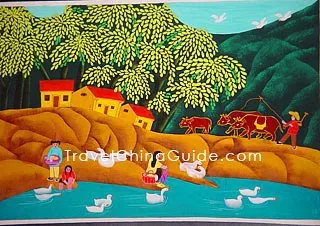 No matter what the subject or the style, traditional Chinese painting should be infused with imagination and soul. A traditional story that captures the Chinese view of painting tells about the establishment of a royal college of painting during the reign of Emperor Huizong. Examinations were held to recruit the best painters. Examinees were asked to draw a picture that reflected the joy of people who had just returned from a spring outing, an outing that had been so pleasant that even the horseshoes seemed fragrant. Many endeavored to depict this bright scene but only one work was chosen; the painter simply drew a horse's hoof followed by butterflies which were in graceful flight. This painter had managed to capture the essential spirit and beauty of the scene. From: www.travelchinaguide.com.
No matter what the subject or the style, traditional Chinese painting should be infused with imagination and soul. A traditional story that captures the Chinese view of painting tells about the establishment of a royal college of painting during the reign of Emperor Huizong. Examinations were held to recruit the best painters. Examinees were asked to draw a picture that reflected the joy of people who had just returned from a spring outing, an outing that had been so pleasant that even the horseshoes seemed fragrant. Many endeavored to depict this bright scene but only one work was chosen; the painter simply drew a horse's hoof followed by butterflies which were in graceful flight. This painter had managed to capture the essential spirit and beauty of the scene. From: www.travelchinaguide.com.
Ochre: Elegant Jewelry
Note: availability of all jewelry products is LIMITED. Many of the items offered are truly unique; only one is available. Generally, this is true more so for the gemstone pendants, but all products are subject to limited inventory. We will attempt to keep the web site current, but be aware that items offered may no longer be available. We apologize for the inconvenience, and we're happy to suggest an alternative.
David MacDonald, Potter and Syracuse University Ceramics Professor
He draws much of his inspiration from the myriad examples of surface decoration that are manifested in the many ethnic groups of sub-Saharan Africa (such as pottery decoration, textiles, body decoration, and architectural decoration).
MacDonald's work spans the complete spectrum of ceramic forms of a utilitarian nature. More info davidmacdonaldpottery.com.






